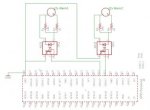gar
Senior Member
- Location
- Ann Arbor, Michigan
- Occupation
- EE
151209-2010 EST
jfouts:
Rereading your original post and looking at your circuit diagram I am confused.
Also in the first post.
Suppose that your different pieces of equipment are isolated from each other, then how isolated?
Suppose highly isolated, then what unintended consequences might result from connecting their commons together?
I would, as I said before, use an optical coupler for communicating the lamp status to the Rasberry. This introduces only a few picofarads of coupling between the different pilot lamps. Wiring may create more coupling than the optocouplers.
Another consideration on your voltage regulator approach is the output voltage tolerance of the regulator, and how much overvoltage a Rasberry input can tolerate.
.
jfouts:
Rereading your original post and looking at your circuit diagram I am confused.
What does this mean? Your drawing shows a common negative rail for all of the lamps. If the drawing is correct, then that means all the 12 VDC voltage sources have a common reference point, and then they are not isolated.Each lamp has its own 12VDC source voltage.
Also in the first post.
This statement does not correspond with your drawing.Typically I would connect all grounds together for a single common ground, but since these lamps are being fed from multiple different pieces of equipment on their own isolated circuits, should I be concerned about connecting all of my grounds together?
Suppose that your different pieces of equipment are isolated from each other, then how isolated?
Suppose highly isolated, then what unintended consequences might result from connecting their commons together?
I would, as I said before, use an optical coupler for communicating the lamp status to the Rasberry. This introduces only a few picofarads of coupling between the different pilot lamps. Wiring may create more coupling than the optocouplers.
Another consideration on your voltage regulator approach is the output voltage tolerance of the regulator, and how much overvoltage a Rasberry input can tolerate.
.




